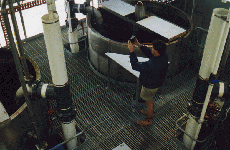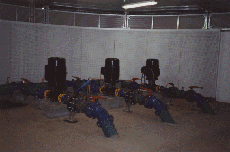
Aqwest-Bunbury Water Board has introduced a range of cleaner production measures designed to improve the overall efficiency of its water treatment plants.
Aqwest, the operating arm of the Bunbury Water Board, supplies water to approximately 12,000 service connections for the 30,000 residents of the town of Bunbury, Western Australia, 180km south of Perth.Aqwest operates seven water treatment plants, associated bores and high level booster pumps. Its main activities are water treatment and water distribution.
In 1996/97, it had a turnover of $5.1 million and a workforce of 27.
In 1983, the water treatment and distribution system was fairly archaic, with 9 water treatment plants and 13 high level booster pump stations spread along the sandy coastal strip around Bunbury.Systems were uncontrolled and uncoordinated. Water pressures fluctuated hour by hour, day by day, and season by season. Pumping pressures placed considerable stress on equipment and components.
Use of equipment was inefficient; there were no energy or demand management programs in place; nor any comprehensive asset management program.
Customer satisfaction with water quality was low.
Cleaner production initiatives introduced included:
- improvements to the operational efficiency of plant and equipment;
- process efficiency improvements eg calculations of kilowatt hour/kilolitre ratios for each treatment plant has allowed plants to be ranked on the basis of their energy efficiency;
- introduction of a control and data acquisition system, so that all treatment plants can be monitored from a single remote control point;
- introduction of a new water treatment system, which allows the water used to clean the filtration systems to be recycled.

Continuous backwash, water efficient, Dyna Sand Filters
The integration of water sources, storage and point of supply systems with the mains reticulation system, has improved operational efficiencies and plant utilisation.The hydraulic performance (or energy required to move water) of individual treatment plants has been improved, and energy costs reduced as a consequence.
The measures have allowed greater utilisation of Aqwestís more efficient plant, and reduced the need to operate older less efficient plant. In addition, a substantial increase in the efficiency of booster pump stations has been achieved, through the rationalisation of pump stations into four sites, and the installation of devices designed to match water demand and pumping operations. Booster pump station energy savings of 75 percent have been achieved from this measure alone.

Energy efficient variable speed drive pumps
The installation of the new booster pump stations has obviated the need for four new high level water towers, with savings of $2.2 million. In conjunction with various other Aqwest initiatives, including time of use tariffs, energy consumption and energy costs have been reduced by 13.5 percent and 24.5 percent respectively.Better overall control and monitoring of the system has resulted in improved water supply quality and service.
Since electricity is Aqwestís biggest fixed cost, there is strong incentive to achieve reductions.However, the pressures associated with the State-wide water industry reforms instigated in 1983, were essentially responsible for the major changes made over the past 15 years in the Boardís water treatment and distribution process.
The Board was allowed to remain independent, subject to improved performance at the technical level and new directions being taken in strategic management.
A concerted program of efficiency measures was progressively put in place through a process of internal reform covering all aspects of operations.
There is strong continuing incentive within Aqwest to achieve best practice and position the organisation strategically against future competitors.
There were no major barriers once the challenge to retain independence from State-wide single authority initiatives implemented in 1983 was taken up and actively pursued.There was strong community support for independence; the Board was allowed to increase water charges; and new development charges were introduced to fund headworks infrastructure ie the equipment required to extract, store and treat water, and deliver it to trunk pipelines.
Mr Geoff Oddy
Chief Executive Officer
Aqwest-Bunbury Water Board
PO Box 400
Bunbury
WESTERN AUSTRALIA 6231
Ph: 61 8 9780 9507
Fax: 61 8 9780 9509Case study coordinated by the Environment Management Industry Association of Australia (EMIAA), April 1998.
![]()
The Cleaner Production Case Studies Directory is part of EnviroNET Australia.
- For more information contact:
Environment Australia
Environment Protection Group
PO Box E305
KINGSTON ACT 2604
AUSTRALIA
Email: cproduction@ea.gov.au
URL: http://www.environment.gov.au/net/environet.html